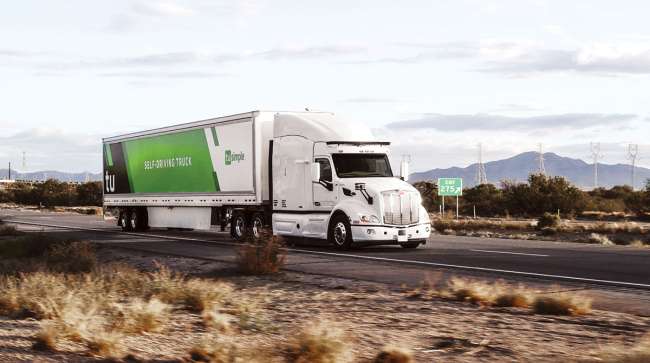Senior Reporter
FMCSA Technology Chief Says Automated Truck Proposal Targeted for Late 2022

[Stay on top of transportation news: Get TTNews in your inbox.]
A top Federal Motor Carrier Safety Administration official told safety executives attending a commercial vehicle safety conference that a proposed rulemaking for fully automated heavy trucks is targeted for later this year. However, he cautioned, “That’s our target date, but don’t hold me to it.”
Such is the nature of the rulemaking process, which can take years to complete.
“There’s so many hoops to go through, because we have to write it, it’s got to get out of our agency, it’s got to go to Secretary Pete’s office, then it’s got to go to the White House, and back and forth, and forth and back,” said Jeff Loftus, chief of FMCSA’s Technology Division, during a June 2 session of the Midwest Commercial Vehicle Safety Summit in Kansas City, Mo. (‘Secretary Pete’ refers to Department of Transportation head Pete Buttigieg).

Loftus
FMCSA began seriously addressing autonomous trucks in 2017 with public listening sessions and recommendations from one of its advisory committees. In 2019, it issued an Advance Notice of Proposed Rulemaking seeking comment on how to safely regulate automated truck activity, including driver standards and maintenance programs.
Now, Loftus said, automated truck testing is ramping up fast, advancing to 28 states. Much of the testing is taking place in the Texas Triangle of Dallas, Houston and San Antonio, along Interstate 10 going from Los Angeles to Jacksonville, Fla, or in Arizona. Across these tests, more than 100 trucks have been retrofitted with self-driving technology, and all use safety drivers.
He noted, however that there has been some driver-out testing. For example, Loftus said autonomous developer TuSimple in late 2021 made seven 80-mile trips along open interstate between Tucson and Phoenix during overnight hours with no driver. There were, however, state patrol officers traveling nearby.
He also named Aurora, Locomation, Waymo and Embark among companies developing the technology.
“They’re really software companies acting like trucking companies, but their ultimate goal is to provide the driving software and work with the truck makers, as well as the fleets,” Loftus said. “Incremental deployment and incremental testing progress is what we’re seeing.”
Meanwhile, FMCSA continues to urge motor carriers to adopt some advanced driver assistance systems before fully automated trucks get regulatory approval. The agency is involved in an ADAS education effort known as Tech-Celerate Now along with American Trucking Associations, the Owner Operator Independent Drivers Association, American Transportation Research Institute and Virginia Tech Transportation Institute.
The initiative’s website aims to address rumors and myths about ADAS adoption, and offer carriers return-on-investment time frame calculations, Loftus said.
At VTTI, a four-year effort is underway to determine how well ADAS technologies are working. Data is being collected from 85 fleets and 44,000 vehicles — both with and without the technologies.
“There’s a lot of buzz about ADAS, but there’s not a lot of empirical data out there for trucking ADAS. This is one of the first studies that’s going to look at it,” Loftus said.
“The preliminary numbers are aligning with the anecdotal data that we have from big fleets,” he said. “They’re seeing dramatic reductions in rear-end crashes and other types of crashes, as well as reductions in severity.”
Want more news? Listen to today's daily briefing above or go here for more info
That aligned with the findings of another panelist, Michael Lasko, who manages Safety and Quality for Boyle Transportation, an early adopter of ADAS technologies.
“These technologies work. They work extremely well,” he said. “The challenge is getting drivers to understand and accept [them],” he said. “Some drivers are very resistant or reluctant to embrace this technology. What we discovered in our investigation was a massive misunderstanding of how these systems operate amongst professional drivers. So we turned to training.”
Since adopting ADAS technologies, Boyle — which hauls high-value, high security goods — has experienced lower per-accident costs, and not a single rear-end collision in 12 years, Lasko said.
“We’ve had excellent results with these technologies,” he said. “Our CSA crash indicator score generally hovers at about zero. In the last seven years we’ve only had two accidents that were reportable where we were at fault. We have completely eliminated catastrophic collisions. We have not had one in over 15 years.”
In a closing session for the event, Max Strathman, an FMCSA division administrator, echoed a central theme expressed by many speakers: Increased funding from Congress for transportation programs presents an opportunity, but also a challenge to find the best ways to spend it.
“Money has always been a convenient excuse,” Strathman said. “We can’t do this because we don’t have the funding. Well, that’s been taken off the table now. Now it’s time for us to use our imagination to look at the data to find out where we want to go.”



